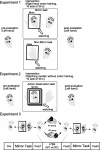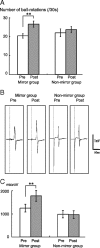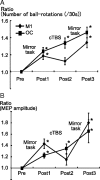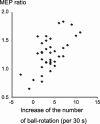Human motor plasticity induced by mirror visual feedback
- PMID: 22279214
- PMCID: PMC6796271
- DOI: 10.1523/JNEUROSCI.5364-11.2012
Human motor plasticity induced by mirror visual feedback
Abstract
The clinical use of mirror visual feedback (MVF) was initially introduced to alleviate phantom pain, and has since been applied to the improvement of hemiparesis following stroke. However, it is not known whether MVF can restore motor function by producing plastic changes in the human primary motor cortex (M1). Here, we used transcranial magnetic stimulation to test whether M1 plasticity is a physiological substrate of MVF-induced motor behavioral improvement. MVF intervention in normal volunteers using a mirror box improved motor behavior and enhanced excitatory functions of the M1. Moreover, behavioral and physiological measures of MVF-induced changes were positively correlated with each other. Improved motor performance occurred after observation of a simple action, but not after repetitive motor training of the nontarget hand without MVF, suggesting the crucial importance of visual feedback. The beneficial effects of MVF were disrupted by continuous theta burst stimulation (cTBS) over the M1, but not the control site in the occipital cortex. However, MVF following cTBS could further improve the motor functions. Our findings indicate that M1 plasticity, especially in its excitatory connections, is an essential component of MVF-based therapies.
Figures






Similar articles
-
Enhancing mirror visual feedback with intermittent theta burst stimulation in healthy adults.Restor Neurol Neurosci. 2019;37(5):483-495. doi: 10.3233/RNN-190927. Restor Neurol Neurosci. 2019. PMID: 31424421
-
Increases in motor cortical excitability during mirror visual feedback of a precision grasp is influenced by vision and movement of the opposite limb.Neurosci Lett. 2018 Aug 10;681:31-36. doi: 10.1016/j.neulet.2018.05.026. Epub 2018 May 19. Neurosci Lett. 2018. PMID: 29787788
-
Motor Cortex Plasticity during Unilateral Finger Movement with Mirror Visual Feedback.Neural Plast. 2016;2016:6087896. doi: 10.1155/2016/6087896. Epub 2015 Dec 31. Neural Plast. 2016. PMID: 26881121 Free PMC article.
-
Role of the mirror-neuron system in cross-education.Sports Med. 2014 Feb;44(2):159-78. doi: 10.1007/s40279-013-0105-2. Sports Med. 2014. PMID: 24122078 Review.
-
Plasticity and functional recovery in neurology.Clin Med (Lond). 2005 Jul-Aug;5(4):368-73. doi: 10.7861/clinmedicine.5-4-368. Clin Med (Lond). 2005. PMID: 16138492 Free PMC article. Review.
Cited by
-
Improving motor performance without training: the effect of combining mirror visual feedback with transcranial direct current stimulation.J Neurophysiol. 2015 Apr 1;113(7):2383-9. doi: 10.1152/jn.00832.2014. Epub 2015 Jan 28. J Neurophysiol. 2015. PMID: 25632079 Free PMC article. Clinical Trial.
-
Mirror and Vibration Therapies Effects on the Upper Limbs of Hemiparetic Patients after Stroke: A Pilot Study.Rehabil Res Pract. 2018 Nov 4;2018:6183654. doi: 10.1155/2018/6183654. eCollection 2018. Rehabil Res Pract. 2018. PMID: 30519490 Free PMC article.
-
Cortical mapping of mirror visual feedback training for unilateral upper extremity: A functional near-infrared spectroscopy study.Brain Behav. 2020 Jan;10(1):e01489. doi: 10.1002/brb3.1489. Epub 2019 Dec 5. Brain Behav. 2020. PMID: 31805613 Free PMC article.
-
Direct and crossed effects of somatosensory electrical stimulation on motor learning and neuronal plasticity in humans.Eur J Appl Physiol. 2015 Dec;115(12):2505-19. doi: 10.1007/s00421-015-3248-z. Epub 2015 Sep 3. Eur J Appl Physiol. 2015. PMID: 26335625 Free PMC article.
-
The Effects of Mirror Feedback during Target Directed Movements on Ipsilateral Corticospinal Excitability.Front Hum Neurosci. 2017 May 11;11:242. doi: 10.3389/fnhum.2017.00242. eCollection 2017. Front Hum Neurosci. 2017. PMID: 28553218 Free PMC article.
References
-
- Altschuler EL, Wisdom SB, Stone L, Foster C, Galasko D, Llewellyn DM, Ramachandran VS. Rehabilitation of hemiparesis after stroke with a mirror. Lancet. 1999;353:2035–2036. - PubMed
-
- Ausenda C, Carnovali M. Transfer of motor skill learning from the healthy hand to the paretic hand in stroke patients: a randomized controlled trial. Eur J Phys Rehabil Med. 2011;47:417–425. - PubMed
-
- Aziz-Zadeh L, Maeda F, Zaidel E, Mazziotta J, Iacoboni M. Lateralization in motor facilitation during action observation: a TMS study. Exp Brain Res. 2002;144:127–131. - PubMed
-
- Brown LE, Wilson ET, Gribble PL. Repetitive transcranial magnetic stimulation to the primary motor cortex interferes with motor learning by observing. J Cogn Neurosci. 2009;21:1013–1022. - PubMed
Publication types
MeSH terms
LinkOut - more resources
Full Text Sources
Miscellaneous
